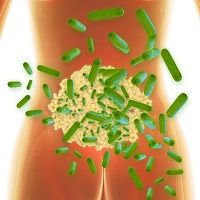Article
New Study Links BMI, Lipid Levels to Gut Microbes
Author(s):
Analysis of a large cohort group has found a significant connection between gut microbes and 2 of the largest risk factors for diabetes.
has found a significant connection between gut microbes and 2 of the largest risk factors for diabetes: body mass index (BMI) and lipid levels.
Investigators examined links between metabolic outcomes and digestive bacteria in 893 subjects from the LifeLines-DEEP population cohort. After adjusting for potential confounders such as age and sex, they found 34 bacterial taxa to be associated with patient BMI and lipid levels. A number of the bacteria had been linked to metabolic outcomes before, but many of the associations were novel.
The investigators then performed cross-validation analysis, which found that microbiota explain 4.5% of the variance in BMI, 6% of the variance in triglyceride levels and 4% of the variance in high-density lipoproteins (HDL), independent of age, sex or genetic risk factors.
“The power of our study is reflected by 3 factors,” the study authors wrote in Circulation Research. “First, to our knowledge, it is the largest association study linking the gut microbiome to blood lipids in humans to date. Second, our cohort represented a wide range of ages, BMI and blood lipids, as well as microbial composition. We also had detailed medication information per individual and could exclude those taking lipid-lowering or antibiotic medication.”
In general, a greater variety of digestive bacteria was associated with healthier weight and lipid figures. The investigators calculated the number of unique bacterial sequences in each patient — i.e. the number of operational taxonomic units (OTUs) — and found numbers that ranged from 44 to 355. Subsequent analysis found that OTU richness was negatively correlated with BMI (P=3.8x10-4) and triglycerides (P=1.37x10-4), but positively correlated with HDL (P=8.3x10-4). Further analysis did not find any connection between levels of low-density lipoprotein (LDL) or total cholesterol.
The new analysis provides further evidence that a number of bacteria identified in early studies are significantly associated with variations in BMI. Indeed, of the 22 taxa that were found to be related to BMI in the new study, 16 were also identified in a study of 416 twins from the UK. The new study found particularly strong evidence connecting high BMI with low levels of bacteria from families Christensenellaceae and Rikenellaceae.
Among the microbes first connected with BMI and triglycerides by the new study are several that play some role in the bile acid metabolic pathway. For example, those from order Bacteroidales (phylum Bacteroidetes) and family Clostridiaceae (phylum Firmicutes) were already known to be involved in bile acid metabolism.
The authors of the new study wrote that research into gut microbiota might prove more practical than research into other factors known to influence BMI, lipid levels, and the wide range of diseases they precipitate.
“In contrast to genetics, gender, and age (all fixed characteristics), an individual’s microbiota
composition can be modified by diet, pre- and probiotics, and fecal transplantation,” they wrote.
“Our study supports the potential of microbiota-modifying intervention to correct lipid dis-balance and thereby help prevent [disease]. From potential to action, the next steps are to validate the associations we report in independent cohorts and to prove there is a causal axis of gut microbiome-lipids-[disease] in functional studies.”





